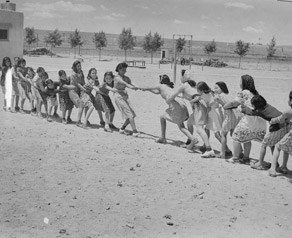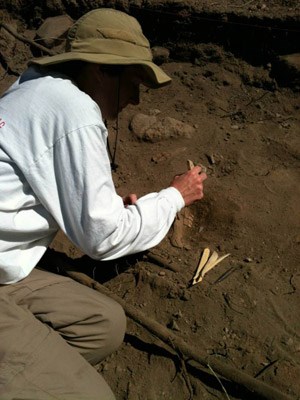
Photographer unknown. From General Photographs of Indians, compiled 1900-1957. Courtesy of the U.S. National Archives and Records Administration.
The Spanish Colonial Missions of the Southwest Travel Itinerary was produced by the National Park Service (NPS) Office of Outreach, Education and Training (including the former Heritage Education Services office) and the NPS Archeology Program in partnership with the Drachman Institute at the University of Arizona, the Latino Research and Training Center at the University of New Mexico (UNM) , the Spanish Embassy in Washington, DC., the NPS Desert Southwest Cooperative Ecosystem Studies Unit, and the National Conference of State Historic Preservation Officers. The itinerary features units of the National Park System and other places listed in the National Register of Historic Places that preserve and tell the stories of Latino/Hispanic and American Indian heritage in the United States and the role Latinos and American Indians have played in American history and the development of the nation. The itinerary uses registration information on historic places in the NPS National Register of Historic Places and National Historic Landmarks collections and National Park Service websites and brochures for units of the National Park System, and other information. Much of the collection is online, particularly for the units of the National Park System and National Historic Landmarks that are included in this itinerary.
The concept for a mission itinerary for the Spanish missions of Arizona, New Mexico, and Texas was developed by the NPS WASO Archeology Program and the Government of Spain. Carol D. Shull, former Interim Keeper of the National Register of Historic Places and Chief, Heritage Education Services, National Park Service, developed the layout for the itinerary, edited it, and provided overall management of its production. R. Brooks Jeffery, Director of the Drachman Institute at the University of Arizona's College of Architecture Planning and Landscape Architecture (CAPLA) and Professor and Coordinator of the Heritage Conservation Program, was the Project Manager for the itinerary. Dr. Joseph Sánchez, UNM director of the National Park Service's Latino Heritage and Training Center at the University of New Mexico and former Superintendent of the Petroglyph National Monument, wrote three essays: "The Significance of Spanish Colonial Missions to our National Story and our Common Heritage with Spain, Mexico and Latin America: An Overview," "Life in the Missions: Between Reality, Romance and Revolt" and "A Day in the Life of a Spanish Missionary: Friar Alonso de Benavides, 1630." Alfredo Jiménez, Professor Emeritus at the University of Seville, wrote the essay "Spanish Missions in the United States: Cultural and Historical Significance." R. Brooks Jeffery, wrote the essay "Spanish Colonial Missions: Architecture and Preservation." Nicole Mathwich, Graduate Research Assistant at the Drachman Institute, wrote most of the itinerary content, selected the photos, and wrote the captions.

2013. Photo by Barnet Pavao-Zuckerman.
Last updated: September 3, 2015
